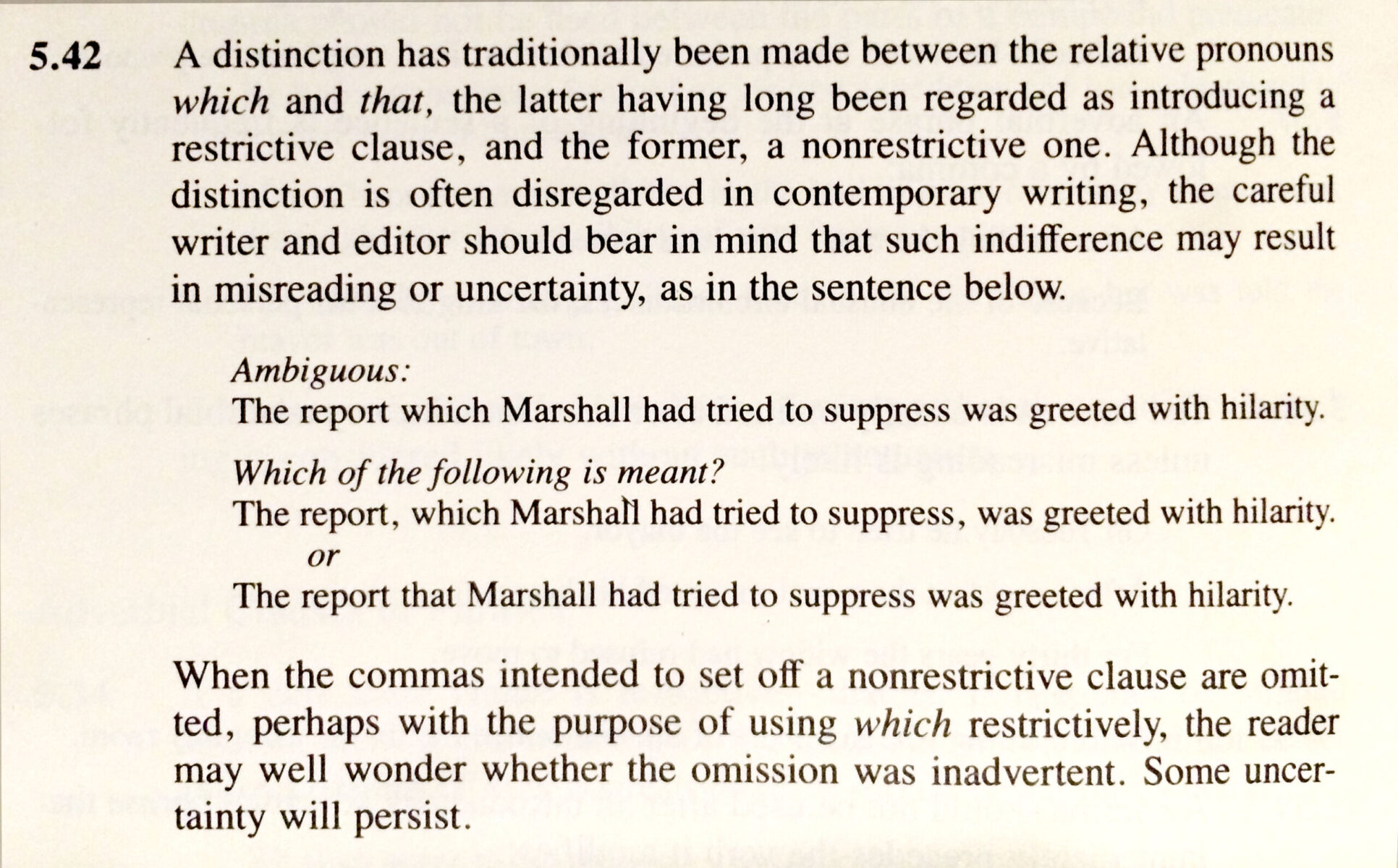“The movie which I saw last week was terrific!” “The movie that I saw last week was terrific!” You might think the sentences above are just two different ways of saying the same thing—but only one is grammatically correct. The distinction arises because words, phrases, and clauses can be restrictive (essential to the sense of the sentence) or nonrestrictive. It’s really quite simple. (Cue sadistic, maniacal laughter in background.)
The Practical Distinction
If it comes after a comma, use “which.” If there’s no comma before, use “that.”
The Technical Distinction
“That” is restrictive–it restricts, or narrows, the field of discussion to pinpoint a specific example. You don’t use commas around the restrictive phrase because it’s crucial to the sense of the sentence.
“The grammar article that Elliot wrote doesn’t need any revision.”
I’m restricting the universe of all grammar articles to just the one that Elliot wrote. Without the restriction, you can’t identify the entry I mean.
“Which” is nonrestrictive–it merely adds more information to something that has been already been identified. A nonrestrictive phrase is surrounded by commas because it is incidental and can be removed from the sentence.
“The grammar article on restrictive phrases is terrific. The article, which Elliot wrote, doesn’t need any revision.”
This time there’s no need for further restriction; the first sentence has identified the article in question. I’m just adding some more info about the entry (namely, its author). The whole phrase “which Elliot wrote” could be deleted without confusion.
So far, so good? Here’s another example to emphasize the importance of correct usage:
“Take a right turn at the third street that has a billboard.”
Because of the restriction, we’re not talking about any old streets–only those with billboards. You may drive past ten streets before you get to the third one that has a billboard. Without the restriction, you’d be lost.
“Take a right turn at the third street, which has a billboard.”
Now, “the third street” is adequate to describe the one you want. The information about the billboard is helpful but not crucial–without that nonrestrictive phrase, you’d still turn at the same place (the third street you come to, regardless of billboards).
Isn’t this fun? Restrictive vs. nonrestrictive isn’t limited to “that” and “which.” Check these out:
“Hamlet, by Bill Shakespeare, is long and depressing.”
Use commas because the author info is nonrestrictive–you don’t need it to identify the play.
“The dictionary by Webster is your best buy.”
No commas, because without the restrictive phrase “by Webster” you can’t identify the one you want.
WRONG (probably): “Hildegard’s husband Oswald loves grammar.”
Without commas around “Oswald,” you’re implying that the information is crucial and therefore restrictive–i.e., that without naming him, you wouldn’t know which of Hildegard’s husbands was being referenced.
RIGHT (probably): “Hildegard’s husband, Oswald, needs psychiatric treatment.”
I don’t know, maybe Hildy is polyandrous … but if not, this is the proper way to reference her spouse.
If you’re still reading, I have just one last thing to (hesitantly) add: “which” doesn’t ALWAYS have a comma in front of it. All the above cases used “which” as a relative pronoun, because it was referring to a noun that directly preceded it. If you use “which” as something else–say an adjective–it’s an entirely different matter.
RIGHT: “I don’t know which entry to edit first.”
No comma before, since “which” is now active as an adjective modifying “entry.”
Here endeth the sermon.

